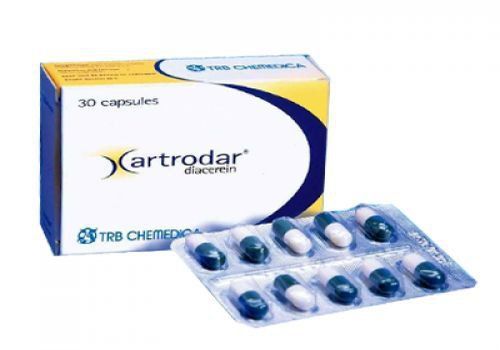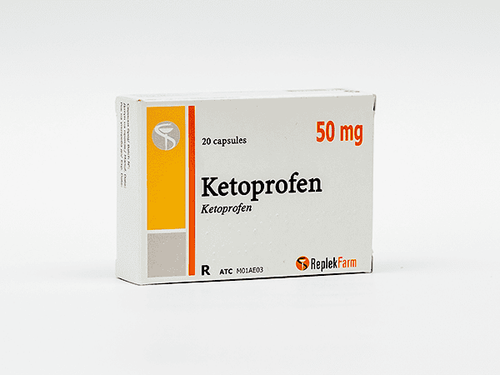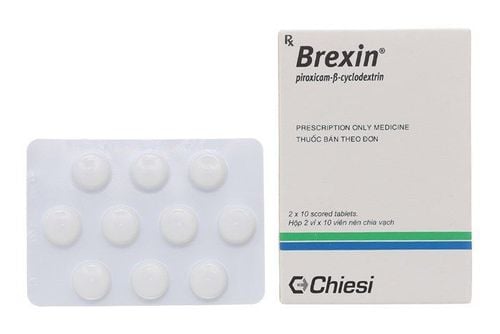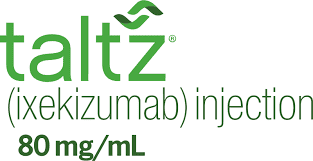This is an automatically translated article.
Dimicox is one of the drugs used to treat long-term symptoms of degenerative joint disease, ankylosing spondylitis and other chronic joint diseases. To better understand what is Dimicox? What are the uses of Dimicox? What are the harmful interactions of Dimicox? What is the correct way to drink? What points to pay attention to, and note when using? The following article will help you better understand the drug Dimicox.1. What is Dimicox?
Dimicox is MeDiSun's effective anti-inflammatory treatment for osteoarthritis and rheumatoid arthritis. Dimicox is also used to help relieve pain caused by bones and joints and spine pain.
The drug has the main ingredient Meloxicam 7.5 mg Prepared in the form of capsules and soft. Packed according to the specification of 1 box of 5 blisters, each blister of 10 tablets. Place of manufacture: manufactured by Me Di Sun Pharmaceutical Joint Stock Company - VIETNAM
Registered by Me Di Sun Pharmaceutical Joint Stock Company.
Indicated drugs: Meloxicam is indicated for the treatment of long-term symptoms, inflammatory attacks, chronic pain in:
Osteoarthritis pain (degeneration, joint damage). Rheumatoid arthritis. Ankylosing spondylitis. Adhere to using the drug according to the instructions or indications (uses, functions for each subject) written on the Dimicox drug instruction sheet or the doctor's prescription sheet.
2. What are the uses of Dimicox?
2.1. Pharmacodynamics: Meloxicam is a non-steroidal anti-inflammatory drug, derived from oxicam. The drug has anti-inflammatory, pain-relieving and fever-reducing effects. Like some other non-steroidal anti-inflammatory drugs, meloxicam also inhibits the synthesis of prostaglandins, mediators that play a very important role in the pathogenesis of swelling, pain, fever and inflammation...
Meloxicam was previously considered a selective COX-2 inhibitor, based on in vitro studies. But when tested in vivo in humans, the selective inhibition of COX-1 over COX-2 is about 10 times and somewhat inhibited the production of thromboxane via COX-1 by platelets at a dose of 15 mg per day. and a dose of 7.5 mg per day. In clinical trials, meloxicam has less gastrointestinal side effects than non-selective COX inhibitors. The degree of COX-1 inhibition of meloxicam is also dose dependent (a dose of 7.5 mg/day is less harmful than a dose of 15 mg/day) and varies from patient to patient. Further clinical follow-up is required to best assess the degree of selectivity for COX-2 inhibition by meloxicam.
Mechanism of action:
Meloxicam is a derivative of oxicam with anti-inflammatory, anti-infective, antipyretic, and analgesic effects. Like some other non-steroidal anti-inflammatory drugs, meloxicam also inhibits cyclooxygenase (COX) which reduces the synthesis of prostaglandins, a mediator but important in the pathogenesis of inflammation, pain, and inflammation. , fever...
Because meloxicam inhibits COX-2 only 10 times more than COX-1, it is classified as a preferential inhibitor on COX-2, and not as a selective inhibitor on COX-2. The degree of COX-1 inhibition by meloxicam is dose dependent and individual patient variability is variable. The daily dose of 7.5 mg inhibits COX-1 less than the 15 mg daily dose. Meloxicam at a dose of 7.5 mg/day and 15 mg/day inhibits COX-1 on platelets and reduces thromboxane A2 synthesis, so it has an antiplatelet effect. Despite its COX-1 inhibitory activity, meloxicam has fewer gastrointestinal side effects than non-selective COX inhibitors.
2.2. Pharmacokinetics Meloxicam is well absorbed from the gastrointestinal tract, oral bioavailability is 89% compared to intravenous administration, food has little effect on absorption. Absorption as capsules, tablets, and rectal suppositories is comparable. In the blood, meloxicam is mainly bound to albumin at a rate of more than 99%. The drug diffuses well into the synovial fluid, the concentration in the synovial fluid is equivalent to 50% of the concentration in the plasma, but the free form in the synovial fluid is 2.5 times higher than in the plasma because there is less protein in the synovial fluid.
Meloxicam is almost completely metabolised in the liver with catalysis mainly by CYP2C9 and to a small extent by CYP3A4. Inactive metabolites are eliminated mainly in the urine and faeces. A small amount of unmetabolized drug is excreted in the urine (0.2%) and feces (1.6%).
The average elimination time of the drug is about 20 hours. In patients with mild or moderate impairment of liver or kidney function (Cl. creatinine > 20 ml/min) no dose adjustment of Meloxicam is required. Meloxicam is not dialyzable.
2.3. Contraindications of the drug Dimicox Cases that should not be used Dimicox
Meloxicam should not be used in the following patients:
Patients with a history of hypersensitivity to meloxicam or to any of its ingredients. Patients with cross-sensitivity to Aspirin and other non-steroidal anti-inflammatory drugs. The patient has a history of asthma, nasal polyps, angioedema or urticaria after taking aspirin or other nonsteroidal anti-inflammatory drugs. Patients with advanced peptic ulcer. Patients with severe liver failure. Patients with severe renal failure without hemodialysis. Children under 15 years old. Pregnant and lactating women. Normally, people who are allergic to any of the ingredients in the drug should not use the drug. Other cases are specified in the drug leaflet or doctor's prescription. Contraindications to the drug Dimicox must be understood as an absolute contraindication, ie not for any reason that contraindications can be used flexibly.
3. Adverse drug interactions of Dimicox
3.1. Drug interactions: Meloxicam should not be combined with the following drugs:
Other non-steroidal anti-inflammatory and analgesic drugs: increased risk of gastrointestinal bleeding due to synergistic effects. Anticoagulants, thrombolytics (ticlopidine, heparin): increase the risk of bleeding. Lithium: increases the concentration of lithium in the blood plasma. Methotrexate: increased toxicity on the hematopoietic system. IUDs: Non-steroidal anti-inflammatory drugs have been reported to decrease the effectiveness of intrauterine devices. Caution should be exercised when meloxicam is co-administered with the following drugs:
Diuretics: increased potential for acute renal failure in dehydrated patients. Antihypertensives (e.g. beta-blockers, ACE inhibitors, vasodilators, diuretics): by reducing the antihypertensive effect. Cholestyramine: increases the elimination of Meloxicam by binding in the gastrointestinal tract. Ciclosporin: Meloxicam increases the nephrotoxicity of Ciclosporin. Use in pregnancy and lactation:
Meloxicam should not be administered to pregnant or lactating women, although no teratogenic effects were observed in preclinical trials. Effects of drugs on driving and operating machines: There have been no studies on the effects of the drug on the ability to drive and use machines. However, if side effects such as dizziness and drowsiness occur, driving or operating machinery should be avoided.
3.2. Dimicox side effects Gastrointestinal: Abdominal pain, diarrhea, dyspepsia, flatulence, vomiting and transient abnormalities due to changes in liver function parameters. Hematology: anemia, blood count disorders: white blood cell disorders, thrombocytopenia. Concomitant use with drugs that are toxic to the bone marrow, especially methotrexate will be a favorable factor for the decline of blood cells. Skin: Itching, skin rash, urticaria, stomatitis, photosensitivity. Respiratory system: Onset of acute asthma attacks (very rare). Central nervous system: Dizziness, headache, tinnitus, somnolence. Cardiovascular system: Edema, hypertension, palpitations, flushing. Urinary system: increased blood creatinine and/or blood urea. Hypersensitivity reactions: mucosal edema and anaphylactoid reactions Note: Inform the doctor about the side effects encountered when using the drug.
Precautions:
General Precautions Meloxicam should not be used as a substitute for corticosteroids or for the treatment of corticosteroid deficiency. Abruptly stopping corticosteroids can make the condition worse. If a decision is made to discontinue corticosteroid therapy, the dose should be gradually reduced in patients on prolonged corticosteroid therapy. Hepatic Effects: Rarely, serious liver reactions including jaundice, fatal acute hepatitis, hepatic necrosis and liver failure have been reported. Patients with signs and/or symptoms of impaired liver function, or with abnormal liver function tests, should be considered as evidence of a more serious liver reaction during treatment with meloxicam. Treatment with meloxicam should be discontinued if clinical signs and symptoms are associated with progression of liver disease or systemic manifestations appear (eg, eosinophilia, rash...) Use caution when administering Meloxicam in dehydrated patients. Rehydration should be given prior to administration of meloxicam. Caution should be exercised in patients with a history of renal disease. Some metabolites of meloxicam are excreted by the kidneys, requiring close monitoring in patients with severe renal impairment. Fluid retention and edema: Some patients have experienced fluid retention and edema with NSAIDs, including meloxicam. Therefore, as with other NSAIDs, caution should be exercised when meloxicam is administered to patients with fluid retention, hypertension, and heart failure.
Note during pregnancy Can pregnant women take Dimicox pills?
Consider and consult your doctor or pharmacist before taking medicine. Even tested drugs still have risks when used.
Note the breastfeeding period Mothers need to carefully weigh the benefits and risks for mother and baby. Do not arbitrarily use the drug without carefully reading the instructions for use and instructions of the doctor to protect the mother and baby
4. How to use Dimicox effectively
4.1. Dosage - How to use Dimicox for rheumatoid arthritis, ankylosing spondylitis: 2 tablets (7.5 mg)/day. Depending on the response to treatment, the dose can be reduced to 1 tablet (7.5 mg)/day. Osteoarthritis: 1 tablet (7.5 mg)/day. If necessary, the dose can be increased to 2 tablets (7.5 mg)/day. Patients at high risk of adverse reactions: Initiate treatment with 1 tablet (7.5 mg)/day. Patients with severe renal failure requiring hemodialysis: the dose should not exceed 1 tablet (7.5 mg)/day. Children: Dosage has not been determined, so only Meloxicam should be limited to adults. When used in combination with tablets and injections: the total dose should not exceed 2 tablets (7.5 mg)/day. 4.2. Missed dose and treatment It is still best to take the medicine on time as prescribed by the doctor. Taking the medicine at the right time will ensure the best effect of the medicine. Usually can take medicine 1-2 hours from the time ordered by the doctor, should not make up when the time is too far for the next dose. 4.3. Overdose and treatment In the case of drug overdose or taking too much medicine to have an emergency, family members need to bring the prescription/vial of medicine the victim has taken. In addition, family members also need to know the height and weight of the victim to notify the doctor.
5. How should Dimicox be stored?
Store in an airtight container, at a temperature below 30C
Read carefully the instructions for storing the drug on the package and the instruction sheet for Dimicox. Check the expiry date of the medicine. When not in use, the drug should be collected and disposed of according to the instructions of the manufacturer or the person in charge of medicine. Conventional drugs are stored at room temperature, avoiding direct sunlight or high temperature, which can convert the ingredients in the drug.
Expiry date
36 months from date of manufacture.
Please dial HOTLINE for more information or register for an appointment HERE. Download MyVinmec app to make appointments faster and to manage your bookings easily.













